Harmony is the hallmark of consciousness
One evening at Aurovalley Ashram, I walked out of the circular white meditation hall and into the verdant Rishidwar valley soaked in a mauve sunset. The air was filled with devotion. Devotional chants came from both the nearby sadhu’s ashram on the Ganga and from the Kumbh Mela 12 kms down the valley, in Haridwar. Even from the ashram grounds, I could see the lights of Kumbh Mela temples blazing on the hill tops around the sacred city. Many varieties of birds added their songs of love to the devotional mix, as did the warm breeze that blew down from the Himalayan foothills.
I was surrounded completely by nature – by the trees, flowers and birds on the ashram grounds, and the meadows and mist-covered Shivalik Hills of Rajaji National Park that surround the ashram and run alongside the Ganga, India’s most sacred river. I truly felt I was in a paradise created by, and devoted to, the love of the divine.
The next morning after breakfast, I cycled to a peaceful local Hindu temple, and from there to a spot near the ashram gate where I could walk down a rocky path to the Ganga. At the foot of the path, on the river, is a tiny temple and ghat (steps). Although it was only about 9:30 am, it was already very hot and sunny.
I sat in the cool shade of the temple watching the rolling blue-green river and listening to the water gurgle happily over a shoal. The Ganga here is luminous, it seems lit from within, and just watching it induces a refreshing feeling of peace and contentment. After some time, a sadhu (holy man) in saffron orange robes came by and dunked himself in the river. After washing himself, he proceeded to wash his orange kurtah and robes, and scrub his brass vessel with mud to clean it.
At this place, the Ganga travels through a national park and there are almost no people, no buildings here – only pristine nature. On the other side of the river are the mountains and jungles of the park – which, I am told, are home to elephants, king cobras and panthers. To see this sadhu performing his ablutions in this setting, is to see an ancient ritual that has been played out countless times by countless sadhus stretching back thousands of years: It is both commonplace and sublime.
For me it is all part of the remarkable magic of Aurovalley Ashram.
I am writing this on the white marble terrace in front of my airy room at Aurovalley Ashram. I love it here, it is probably my favourite place on earth. I have tried before to describe the peace of this place. There are some such places on earth where nature and man conspire to create havens of solitude and beauty. Aurovalley is one such place.
There is a subtle but powerful energy here that is both peaceful and healing. I have described before how I first came to this ashram on the advice of my friend Kailash, who has been coming here for many years. Soon after arriving I fell into a deep, restful, loving sleep. I slept for only about half an hour but it felt like the best sleep of my life. It was as if loving maternal arms held me as I slept. I woke and felt something I had never felt in my adult life: I felt I was at home.
 Aurovalley is my spiritual home. It has everything I need to recover, heal, grow, create, do my inner work and commune with the divine. The ashram is between Rishikesh and Haridwar, but both of those sacred cities feel like three-ring circuses compared to here. It is set in the countryside, about three kilometres from the nearest village, surrounded by meadows that are ringed by Rajaji National Park. It is not only surrounded by nature, it is a celebration of nature. The ashram grounds are filled with gardens and trees, flowers and birds – it is a garden of eden, a paradise, carefully nurtured and maintained by founder Swami Brahmdev (Swamiji) and the loving people who live and work here.
Aurovalley is my spiritual home. It has everything I need to recover, heal, grow, create, do my inner work and commune with the divine. The ashram is between Rishikesh and Haridwar, but both of those sacred cities feel like three-ring circuses compared to here. It is set in the countryside, about three kilometres from the nearest village, surrounded by meadows that are ringed by Rajaji National Park. It is not only surrounded by nature, it is a celebration of nature. The ashram grounds are filled with gardens and trees, flowers and birds – it is a garden of eden, a paradise, carefully nurtured and maintained by founder Swami Brahmdev (Swamiji) and the loving people who live and work here.I love Aurovalley for the peaceful energy and nature-oriented environment, but that’s not all. I also love the intelligently designed buildings, spaces and daily programme. My room is a simple design, all in white, and air and sunlight flow through unimpeded. It is elegant in its cleanliness and simplicity. I love meditating in the white marble circular meditation hall. Normally, I cannot achieve a deep meditation without asana practice, but in this hall there is so much help, so much deep energy that meditation is actually easy and I have had some remarkably profound insightful and healing experiences.
I love satsang (Sanskrit for “search for truth”) with Swamiji. He sits every morning from 11:30 until 1 pm, lunch time, under a grove of trees outside the library and answers questions, which is the time-honoured method of spiritual instruction in India. Swamiji teaches sadhaks (people who stay at the ashram) to increase their conscious awareness and aspire to live in full faith of the divine. He is a disciple of the teachings of Sri Aurobindo and The Mother. Sri Aurobindo’s non-fiction masterwork is The Integral Yoga — which posits that All Life is Yoga. (His fiction masterwork is the epic mystical poem Savitiri.)
You cannot “do” yoga
But this is not the usual yoga you find at North American yoga studios. Swamiji says, “Millions of people are saying they are doing yoga, but what they are doing has nothing to do with yoga. They are doing some kind of exercises and other things. Yoga means to become One, and to become One is to be centred, to be a balanced person, a conscious person. It is not an outer thing, it is an internal thing. No one can see you are doing yoga. If anybody sees that you are doing yoga, this is not yoga. Yoga us a very secret internal process; it is a way of living with a very high understanding, with clarity. Yoga is not a subject of doing. Yoga is not to do. Yoga is an attitude. You never see a yogi doing yoga.”
The ashram takes care of all needs, including the physical: there is a daily asana class in the newly built and sun-filled yoga hall, three delicious vegetarian meals a day in the communal dining hall (some of the produce comes from the ashram’s organic garden), a library, Internet café, a store that sells books by and about Sri Aurobindo and The Mother (and lovely Auroshika products such as mala beads, oils and incense) and a new Ayurveda clinic. The clinic is staffed by a Colombian allopathic doctor who trained in Ayurveda at a university in Gujurat. She offers complete pancha karma treatment.
For me, the other main highlight of Aurovalley Ashram is its proximity to Ganga Ma, the Ganges River, mother river of India. It is only a short walk through a meadow to the river, which in this place is in a completely natural environment.
Spirituality means simplicity
Upstream from here is Rishikesh and downstream is Haridwar. This year the Maha Kumbh Mela is taking place in Haridwar and it is attracting millions of devotees. The Maha Kumbh Mela is the biggest gathering of humanity on earth. On a recent major bathing day, I went down to the Ganga at sunrise and was for some time the only person on the small ghats (steps) down to the river. It was chilly and I wasn’t sure I wanted to go in the cool water. But something bigger than me impelled me and I found myself carried by a wave of energy into the river. Coming up, I felt such exhilaration. It is very hard to explain. I was joined soon after by four Brahmin men, and we each did our puja and took our dip in silence and separateness. It was lovely, peaceful and deeply moving.
As the sun came up, it tinged the sky and glossy surface of the water an iridescent rosy pink. It was a beautiful scene, primordial in its pristine beauty, and the Hindu ritual to honour the river is ancient, too. I felt such reverence for nature; and such reverence from nature. Indeed, I feel these are the times when I feel closest to the divine
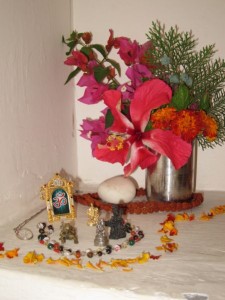 Meanwhile, downstream in Haridwar there were probably literally millions streaming into the Ganga at that same moment. I could hear the chants blaring from loudspeakers 12 kms away. I know some people love the intense energy of such a big crowd and all the attendant music, chanting, pujas, swamis, babas and the like, but I was very content with my peaceful bath.
Meanwhile, downstream in Haridwar there were probably literally millions streaming into the Ganga at that same moment. I could hear the chants blaring from loudspeakers 12 kms away. I know some people love the intense energy of such a big crowd and all the attendant music, chanting, pujas, swamis, babas and the like, but I was very content with my peaceful bath.Life at the ashram offers the rare opportunity for a very quiet, simple existence, centred around inner reflection. Lots of time for reading, writing, walking in nature, meditating. I find that I am healing on a deep level just by being here and participating in the ashram lifestyle. Every moment is an opportunity to live consciously and to grow in understanding. A carving at the entrance to the ancient oracle of Delphi said “know thyself” and that, too, could be the motto of this ashram. In this day and age it is so amazing to find a place like this that completely supports someone who wants to “know thyself” and therefore become a better person and contribute to a better world.
“Know thyself” is a way of life
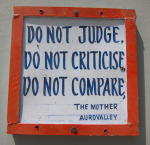 But lest you think being at Aurovalley is an escape from life, or from yourself; or that it offers a naïve and unrealistic “peace and love” panacea, you have only to read some of the *inspirational* signs that are placed around the ashram grounds to discover that this ashram is quite the opposite. In fact, because Swamiji is so clear, honest and rigorous in his thinking and approach; and because the ashram provides so few distractions, there is no escape from yourself here. It is the perfect place to confront yourself and discover how you are: how you think, how you judge, how you avoid, how you evade, etc.
But lest you think being at Aurovalley is an escape from life, or from yourself; or that it offers a naïve and unrealistic “peace and love” panacea, you have only to read some of the *inspirational* signs that are placed around the ashram grounds to discover that this ashram is quite the opposite. In fact, because Swamiji is so clear, honest and rigorous in his thinking and approach; and because the ashram provides so few distractions, there is no escape from yourself here. It is the perfect place to confront yourself and discover how you are: how you think, how you judge, how you avoid, how you evade, etc.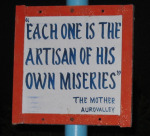 Swamiji is one of the most honest people I know. Some people may find his honesty bracing, but after years of Gestalt therapy I am ready for it and I find it refreshing. For example, I asked him about the concepts of samadhi, nirvana, moksha and enlightenment and he replied that they are, “varieties of ignorance.” He doesn’t agree with the idea of renouncing life or living in a cave in the Himalayas. Life is for living he says. It is to experience, to grow, to move, to change. We live in a garden and we are all gardeners. Our job is to make the garden beautiful – and we do this by living with fearless courage AND consciousness. He says, “Live in the world, but do not let the world live in you.”
Swamiji is one of the most honest people I know. Some people may find his honesty bracing, but after years of Gestalt therapy I am ready for it and I find it refreshing. For example, I asked him about the concepts of samadhi, nirvana, moksha and enlightenment and he replied that they are, “varieties of ignorance.” He doesn’t agree with the idea of renouncing life or living in a cave in the Himalayas. Life is for living he says. It is to experience, to grow, to move, to change. We live in a garden and we are all gardeners. Our job is to make the garden beautiful – and we do this by living with fearless courage AND consciousness. He says, “Live in the world, but do not let the world live in you.”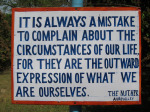 Another example: I asked Swamiji why people go to the Kumbh Mela. He said, “People have within them a need for entertainment.” Of course, he went on the explain that nature has many ways to move and change people; and people have created many ways, too, such as amusements like the Kumbh Mela, movies, etc. I exclaimed, “Is going to a movie the same as the Kumbh Mela?!” and he replied, with lightness, “Well, if it’s a very good movie,” and everyone laughed.
Another example: I asked Swamiji why people go to the Kumbh Mela. He said, “People have within them a need for entertainment.” Of course, he went on the explain that nature has many ways to move and change people; and people have created many ways, too, such as amusements like the Kumbh Mela, movies, etc. I exclaimed, “Is going to a movie the same as the Kumbh Mela?!” and he replied, with lightness, “Well, if it’s a very good movie,” and everyone laughed.When asked about pain or difficulties, Swamiji says that we do not have difficulties – we have only our own rigid natures. Pain he calls a filter, and suffering a gift – they are both teachers. It seems almost everything Swamiji says has the same message: that we are here to learn, change, move and grow, and that it is nature’s, or the divine’s, way to teach us, with whatever means possible. The more positive we are in our response to life, the more conscious we become, the faster we learn.
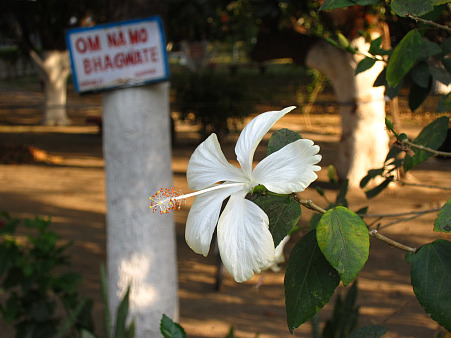 Almost every morning satsang is eye-opening (perhaps I should say third-eye opening!). Recently, he talked at length about healing, and about how nature is filled with healing forces. He made a very persuasive argument for positive thinking and conscious healing as the best *doctor.* In fact, he said “no doctor, no illness.” He teaches that we become what we think. If we think we are healthy, we will be. If we think we are sick, we will be.
Almost every morning satsang is eye-opening (perhaps I should say third-eye opening!). Recently, he talked at length about healing, and about how nature is filled with healing forces. He made a very persuasive argument for positive thinking and conscious healing as the best *doctor.* In fact, he said “no doctor, no illness.” He teaches that we become what we think. If we think we are healthy, we will be. If we think we are sick, we will be.There are many wonderful people who work hard and contribute to making this such a clean, well-maintained and conscious place, but it is primarily the vision of Swamiji, who came here more than 20 years ago when it was just a jungle, and who slowly built it into what it is today – a sanctuary of conscious living. If harmony is the hallmark of consciousness, as Swamiji remarked during satsang, then Aurovalley must be a highly conscious place indeed.







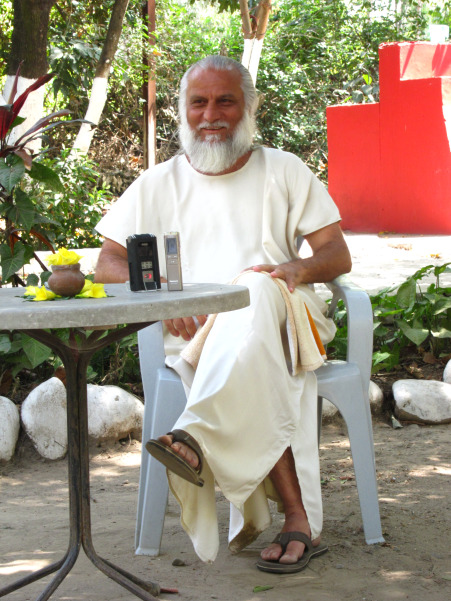
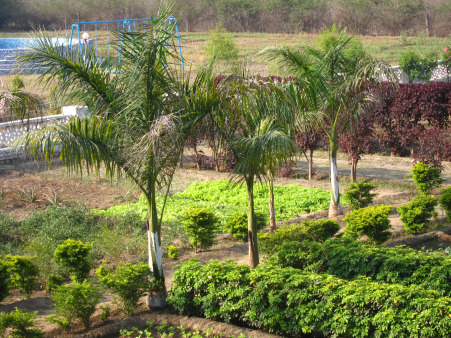
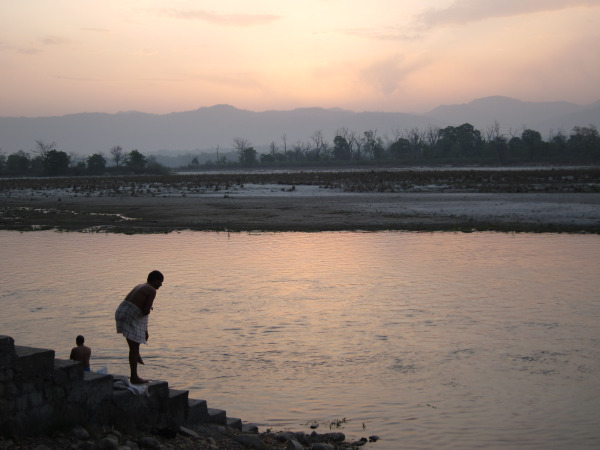

No comments:
Post a Comment